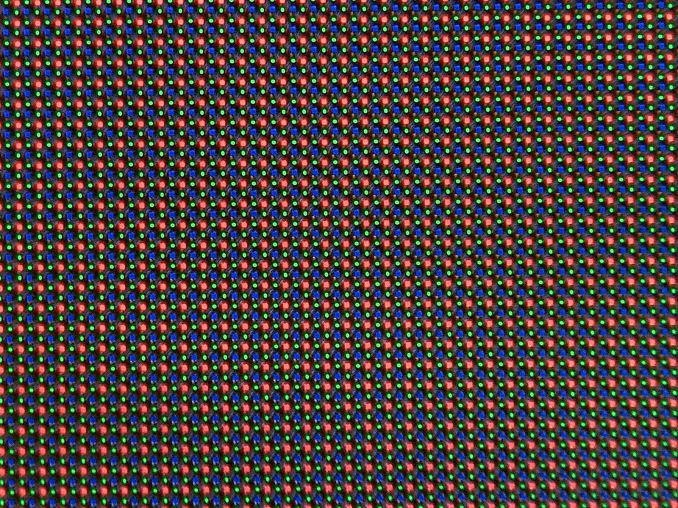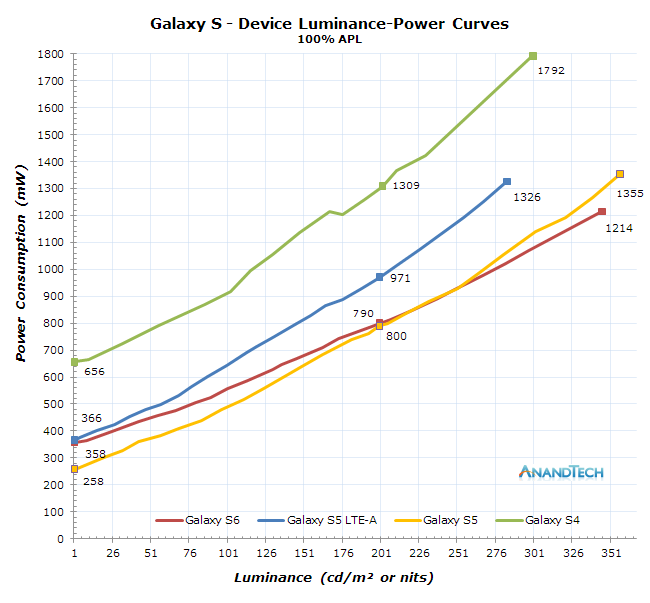Analysing AMOLED Power Efficiency Improvements
by Andrei Frumusanu on June 23, 2015 8:00 AM EST- Posted in
- Smartphones
- Displays
- Samsung
- Mobile
- AMOLED

Over the last few years we’ve been repeatedly reporting how Samsung was able to improve AMOLED power efficiency by employing better emitter materials on each new device generation. This went largely unverified as nobody really tried to accurately measure the actual power consumed by the screen. To rectify this situation, I went ahead to try to measure the screen power consumption of the last 4 generations of Galaxy S devices to get a better understanding just how much emitter improvements have contributed to screen and device battery efficiency.
AMOLED screens are emissive displays, meaning they emit light on their own without having to resort to backlights in transmissive technologies such as LCD screens. This causes white to be the most power-intensive color for an OLED screen to display because it requires all sub-pixels to operate at high emission. The advantage of OLED screen though is that for dynamic content, the technology is able to save power in comparison to transmissive displays because only the pixels which are actually used are powered up.
Because white is a worst-case power scenario, it serves well as good representation of general efficiency gains in OLED devices. I've noticed that the power composition of the display consists of the sum of individual component’s power, and was able to verify this on the Galaxy S6: the sum of pure red, green and blue (in sRGB) was largely correlating with the power consumption of pure white when you take into account APL (Average Picture Level) brightness adjustments of the display.
To get a meaningful representation of efficiency of the displays, we chart the power curve of the Galaxy S4 (E5410), Galaxy S5 (S801), Galaxy S5 LTEA and finally the newest generation Galaxy S6 at different screen luminance points:
Immediately the Galaxy S4 sticks out as the most power consuming device of the last few generations. One has to keep in mind that most of this power is not due to the display itself, but due to the lack of Panel Self Refresh on past generation devices. PSR is able to achieve better power efficient in static screen scenarios by not re-sending frame-buffer information to the screen’s display controller IC. The DDIC instead buffers the screen contents on-chip and refreshes the screen matrix that way, enabling the SoC’s display controller pipeline to shut down and save on power.
Due to inconsistencies in SoCs, DDICs and general component efficiency, each device starts at a different power value at minimum brightness. For example the Galaxy S5 is able to post by far the best value in this metric as it will consume down to 258mW while idling at minimum brightness. The Galaxy S5 LTEA and Galaxy S6 will use a tad more at around 360mW each. This is likely due to the fact because of the heightened resolution of their 1440p screens compared to the 1080p screen on the Galaxy S5.
To be able to determine the efficiency of the OLEDs themselves though, we have to look at how the luminance curve behaves for each device. To do this, one has to adjust the power numbers to compensate for this base-power consumption:
| AMOLED Screen Power Efficiency | ||||||
| Device Minimum Power |
Device Max Power (Manual Br.) |
Screen Luminance Power at 200cd/cm² |
mW / cd / cm² (Normalized to 5.1" screen) |
|||
| Galaxy S4 | 656 mW | 1792 mW | 653 mW | 3.41 | ||
| Galaxy S5 | 258 mW | 1355 mW | 532 mW | 2.66 | ||
| Galaxy S5 LTEA | 366 mW | 1326 mW | 605 mW | 3.02 | ||
| Galaxy S6 | 358 mW | 1214 mW | 442 mW | 2.21 | ||
| Note 4 | 452 mW | 1690 mW | 665 mW | 2.69 | ||
We see a generational improvement in power efficiency for each new Galaxy S device, except the S5 LTEA. It seems that the switch to 1440p effectively brought itself with a loss in efficiency of the screen and the DDIC / base power consumption. We don’t know the details of the emitter materials used for each generation, but I’ve been told that power efficiency of a sub-pixel should theoretically go down relative to its size. The higher DPI density of the S5 LTEA might be reason for its efficiency degradation.
The Galaxy S6 offers the best evidence of new emitter and efficiency gains as it is even clear in the luminosity curve graph how even though the S6’s base power consumption is higher, it is able to catch up this to this difference and surpass the Galaxy S5 at higher brightness levels. The comparison with the S5 LTEA is the most interesting as both devices sport a 5.1” 1440p display making them perfect for an apples-to-apples comparison. Here the S6’s new display is able to exhibit a substantial 36% improvement in power efficiency.
While the generational power efficiency gains compared to older AMOLED devices is interesting, the question remains if the newest displays are now able to match up to LCD panels in terms of efficiency at high APL values.
To get a better idea how power scales depending on APL, grey-scale various colors, I went ahead graphed over 239 measurement points on several display scenarios on the Galaxy S6.
As expected, we see white being the obvious most power consuming color as it requires high intensity on all color components. We again see the interesting behavior of black and white patterns summing up to a certain %APL consume much more power than an equal grey-scale or mixed image at the same APL. As explained in our review of the Galaxy Note 4 Exynos, this is due to voltage scaling of the intensity levels of the sub-pixels. Actual brightness of the display is controlled by pulse wave modulation on top of the component voltage scaling mechanisms.
I’ve yet to measure more LCD devices to get a better picture of various panel manufacturers and screen technologies, but if we take for example the Huawei P8’s panel we can calculate a luminance-power of 332mW at 200cd/cm². Over the Galaxy S6’s AMOLED screen this still represents a 33% advantage for the LCD technology when displaying white and high level greyscale colours. To reach an equivalent amount of efficiency on the S6 one would have to have about less than 65-70% of solid white in the picture. Unfortunately Android interfaces are still dominated by high APL and white elements, so AMOLED will still trail LCDs in most default UI scenarios when it comes to luminance power. As long as white is avoided, the S6 can already claim it is more efficient than LCD devices in all other scenarios as the break-even point now reaches ~85% greyscale.
The good news though is that this gap keeps decreasing with each generation and the disadvantage is limited to pure white background content. Having even slightly grey or colored content will start shifting the scales back in favour of AMOLED devices. Running dark themes and dark backgrounds can really be advantageous for AMOLED device as they are able to achieve factors of 3-4x in luminance-power advantage over LCD devices.












73 Comments
View All Comments
saratoga4 - Tuesday, June 23, 2015 - link
FWIW, Displaymate claims that they measure a multiple brightnesses to back out the screen power consumption from the total device power consumption. They never post their data though, and don't really explain the calculations they use, so I've always been curious how accurate their conclusions were.Shadow7037932 - Tuesday, June 23, 2015 - link
They are using full system/device power and not measuring the actual display power draw.Shadowmaster625 - Tuesday, June 23, 2015 - link
All you have to do is compare video playback battery life and you can clearly see that AMOLED offers nothing tangible in terms of power efficiency.Guspaz - Tuesday, June 23, 2015 - link
There are too many other factors involved in video playback life to say anything meaningful about the power draw of the display. For example, if the audio and video codecs are decoded in hardware versus software. That would make a huge difference in power draw.Andrei Frumusanu - Tuesday, June 23, 2015 - link
Video playback is the one scenario AMOLED offers the biggest power efficiency advantages.Impulses - Tuesday, June 23, 2015 - link
I would think so, given how much darker video tends to be... Most of my time on the phone is spent looking at the UI or web pages like this one tho, shock full o white. :pIf Samsung can actually keep going at the rate they are tho, I'd welcome an AMOLED display in a year's time. Not so sure about a Samsung phone tho, and they tend to keep the best display units for themselves.
Jimios - Tuesday, June 23, 2015 - link
There is too much white on both major mobile operating systems. And not only on the OS itself, but also on most popular third party apps. I own a Samsung Galaxy S4 and even simple usage destroys my battery life because of the whites.Slightly off-topic, but my solution to this was that I flashed a custom ROM based on CyanogenMod, the OS is completely themeable and there is support for theming several third-party apps as well. I just applied a black theme and my battery is now on a different league. As an added bonus, it is lightning fast (feels like a new phone) and I got rid of all the Samsung bloatware as well.
Still, I believe that AMOLED is the right choice for mobile displays going forward. However, I think it will be a while before we start seeing large, desktop AMOLED displays.
mr_tawan - Tuesday, June 23, 2015 - link
Android was using darker-theme (Holo) before they made a switch with Material.soccerballtux - Saturday, June 27, 2015 - link
So stupid that they left that IMHO. whites are so harsh on the eyes at nightmelgross - Tuesday, June 23, 2015 - link
A major problem that still needs to be addressed is the extreme sensitivity to heat that amoled has. We still see the effective max brightness peak at around 350nits, whereas for LCD screens it's around 600 nits.For the S6, Samsung has that special mode for direct sunlightt which allows the screen to go to about 600 nits, but it can't be set as a maximum in settings, because if used other than intermittently, and just occasionally, the screen will burn out. That's still a major deficiency.
And at the same time LEDs for backlighting are increasing their own efficiency every year. I'd like to know what the efficiency of the best LCD and back lights are. I don't know where the Huawei panel is in that group, or what kind of LCD panel it is.
Also, amoled still needs the while Pentile display for maximum brightness, which LCD displays don't. As we know, that dropped effective sharpness by 25-30%, so that a 1440 screen is only about as sharp as a 1008 to 1080 screen. But it wastes GPU energy and processing power. So there are still reasons why LCD screens are better.